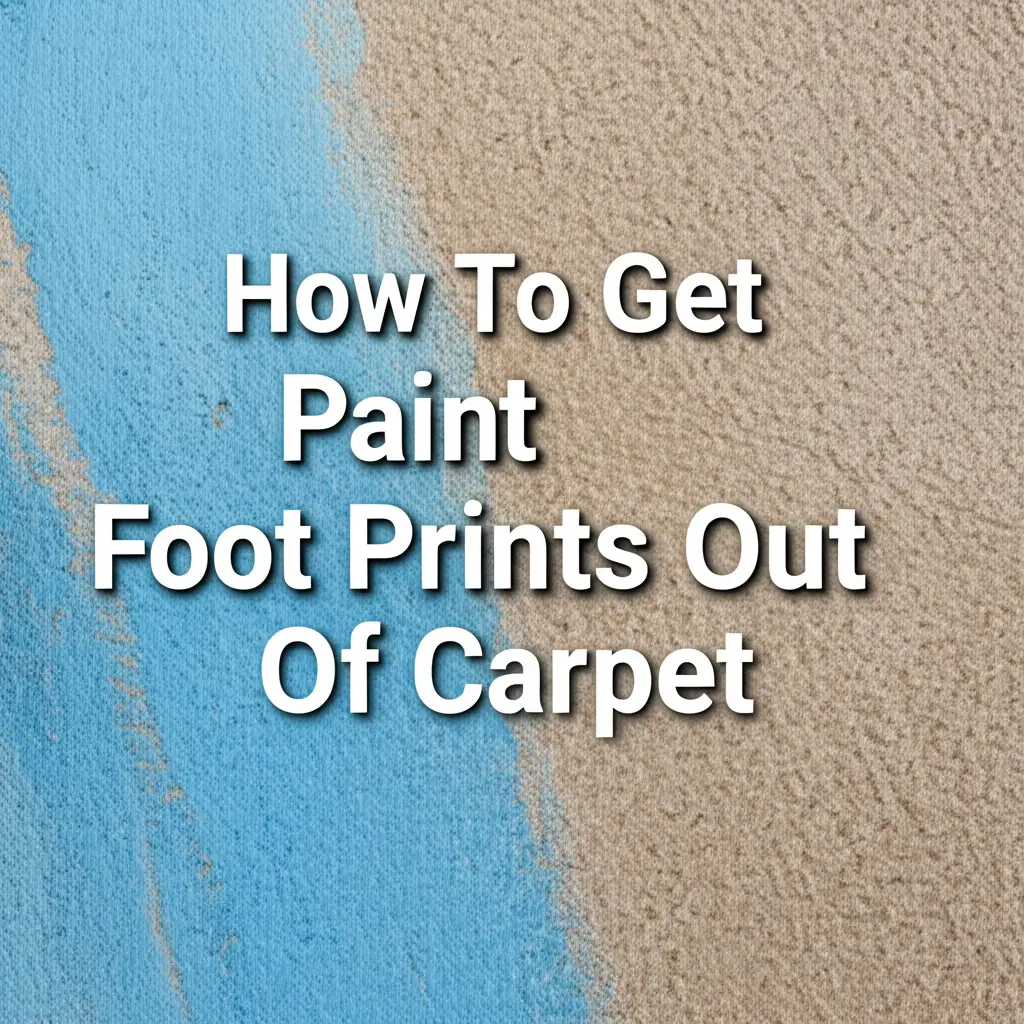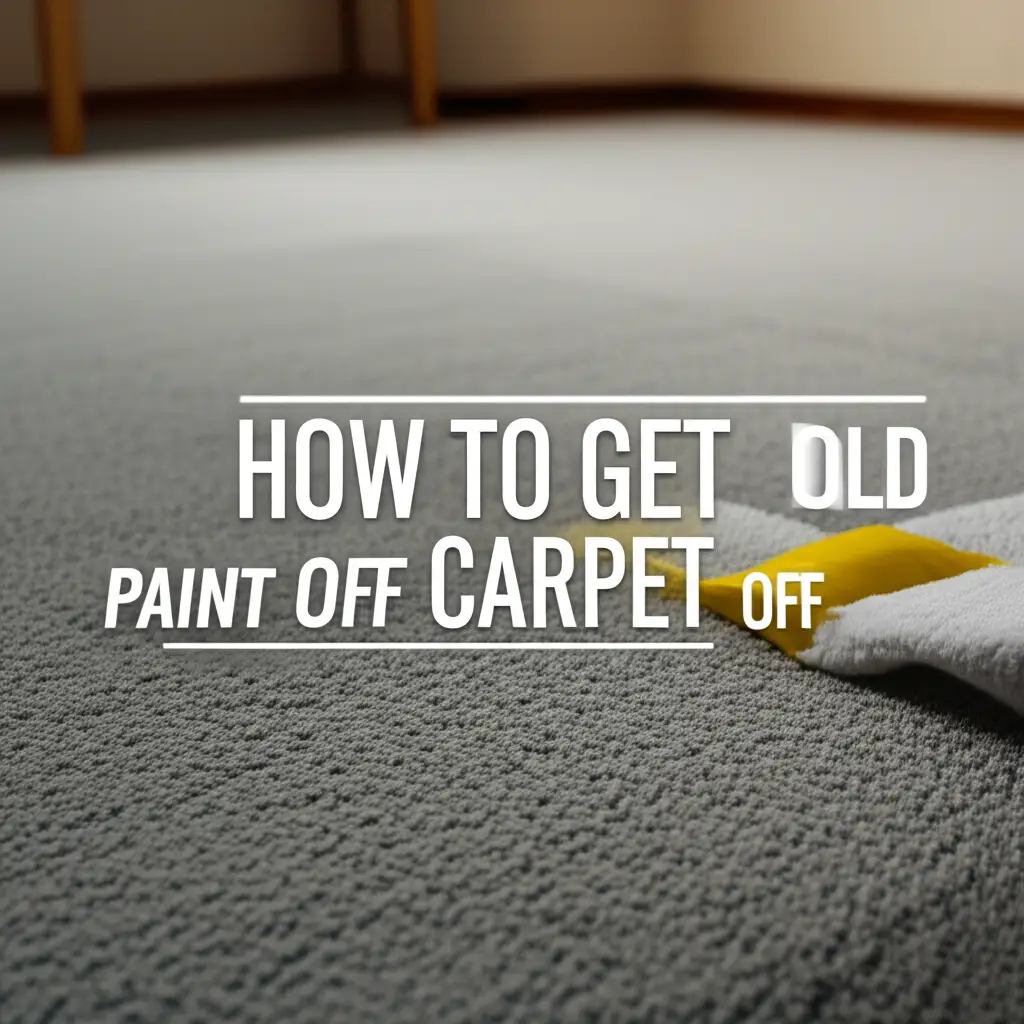· Elira Thomsen · Cleaning & Maintenance · 19 min read
How To Get Paint Foot Prints Out Of Carpet

Remove Paint Footprints: Your Carpet Cleaning Guide
Painting a room can give your home a fresh, new feel. But sometimes, during this process, paint lands where it does not belong. I know the sudden panic that hits when you see a tell-tale paint footprint on your beautiful carpet. It is a common problem for many DIY enthusiasts. However, a paint stain on your carpet does not mean disaster.
Learning how to get paint footprints out of carpet is a valuable skill for any homeowner. This guide will walk you through the proper steps. We will cover identifying the paint type, gathering necessary tools, and applying effective cleaning methods for both wet and dry paint. You will find strategies for various paint types. We also discuss when to seek professional help. By the end, you will know how to tackle these pesky marks with confidence.
Takeaway
- Act Quickly: Remove wet paint immediately for the best results.
- Identify Paint Type: Water-based paints need water; oil-based paints need solvents.
- Blot, Do Not Rub: Rubbing spreads the paint and pushes it deeper into fibers.
- Test Cleaners: Always test any cleaning solution on an inconspicuous area first.
- Scrape Dry Paint: Carefully remove dried paint before applying liquid cleaners.
To get paint footprints out of carpet, first identify if the paint is wet or dry and its type (water-based or oil-based). For wet paint, blot it immediately with a damp cloth. For dry paint, gently scrape excess paint, then use appropriate solvents or cleaning solutions for the specific paint type.
Identify the Paint Type and Dryness
Before you even think about cleaning, you must understand the paint. Paint is not just paint; different types exist. Each type requires a specific approach. Knowing if the paint is wet or dry also impacts your cleaning strategy. This initial assessment saves you time and prevents damage to your carpet.
First, touch the paint mark gently. Is it still sticky and moist? If it is, you are dealing with wet paint. Wet paint is always easier to remove. Time is critical here. The longer wet paint sits, the more it dries and bonds with the carpet fibers.
Next, determine the paint type. Most household paints fall into two main categories: water-based or oil-based. Water-based paints include latex and acrylic paints. These paints are common for interior walls. Oil-based paints are less common for general wall use but appear in specific applications. Artists’ paints can also be oil-based. Check the paint can if you still have it. The label will tell you the paint’s base.
If you do not have the can, a simple test helps. Dab a small amount of paint with a damp cloth. If the paint smears or dissolves easily with water, it is likely water-based. If it resists water and feels greasy, it is probably oil-based. This step is fundamental. Using the wrong cleaner can set the stain permanently. For instance, putting water on an oil-based paint will not work. It can even make the stain harder to remove. Understanding these differences prepares you for the correct action.
Understanding Water-Based Paints (Latex, Acrylic)
Water-based paints are very common in homes. They dry quickly. They also clean up easily with soap and water when wet. These include most wall paints. Acrylic paints, like those found in craft kits, are also water-based. They are made with an acrylic polymer emulsion. This makes them relatively easy to remove if you act fast. You may be wondering, does acrylic paint come out of carpet? The answer is often yes, especially when wet. Even specific brands, like Apple Barrel, can come out. To learn more about removing craft paints, see our guide on how to get apple barrel paint out of carpet.
Understanding Oil-Based Paints
Oil-based paints contain solvents like mineral spirits or alkyd resins. These paints offer durability and a smooth finish. They take longer to dry than water-based paints. They also require different cleaning agents. Water alone will not dissolve them. You need a solvent-based cleaner. Ignoring this can worsen the stain.
Gather Your Tools and Cleaning Agents
Once you identify the paint type and dryness, gather your cleaning arsenal. Having everything ready before you start is important. This prevents frantic searching mid-clean. It also ensures you work efficiently. Each tool and agent plays a specific role. Using the right items makes the job easier and more effective.
Start with basic household items. You will need clean white cloths or paper towels. These absorb the paint without transferring color. A dull knife, spatula, or paint scraper is good for scraping. These help remove dried paint. They also prevent damage to carpet fibers. You might also need a stiff brush, but be careful not to damage the carpet pile.
For cleaning agents, your paint type determines what you need. For water-based paints, warm water and liquid dish soap are often enough. You can also use rubbing alcohol. Isopropyl alcohol works well on many water-based stains. For tougher water-based stains, consider vinegar. Mix it with water for a mild acid solution.
For oil-based paints, you need stronger solvents. Mineral spirits, paint thinner, or turpentine are common choices. Acetone, found in nail polish remover (non-gel), also works on some oil-based paints. Always check the ingredients in your nail polish remover. Acetone is strong, so use it sparingly. Test all solvents in an hidden spot first. This prevents damage to your carpet’s color or fibers.
Safety is also important. Wear rubber gloves to protect your hands from chemicals. Ensure the room has good ventilation when using strong solvents. Open windows or use a fan. Keep children and pets away from the cleaning area. Having the right tools and agents ready sets you up for success. Understanding what gets paint out of carpet involves knowing these specific agents.
Essential Tools for Paint Removal
- Clean White Cloths or Paper Towels: These absorb paint and prevent dye transfer. Use many of them.
- Dull Knife or Spatula: For gently scraping dried paint. A credit card also works well.
- Stiff Brush (Optional): Can help dislodge dried paint, but use with care.
- Vacuum Cleaner: For removing scraped dry paint flakes.
Essential Cleaning Agents by Paint Type
- For Water-Based Paints (Latex, Acrylic):
- Warm Water
- Liquid Dish Soap (mild, non-bleach)
- Rubbing Alcohol (Isopropyl Alcohol)
- White Vinegar (diluted)
- Ammonia (diluted, for stubborn stains, use in well-ventilated area)
- For Oil-Based Paints:
- Mineral Spirits
- Paint Thinner
- Turpentine
- Acetone (nail polish remover, check ingredients)
- Specialty Paint Remover (for carpets, always test first)
Remember, testing your chosen cleaning agent on an unseen part of the carpet is crucial. This helps confirm it will not cause discoloration or damage. A hidden corner or under a piece of furniture works well for this test.
Immediate Action for Wet Paint Footprints
Seeing wet paint on your carpet can make your heart sink. But quick action is your best defense. Wet paint is much easier to remove than dry paint. You must act immediately. Do not delay, as every minute counts. The goal is to remove as much paint as possible before it dries.
First, do not rub the paint. Rubbing pushes the paint deeper into the carpet fibers. This makes the stain larger and harder to remove. Instead, blot the paint. Use a clean, white cloth or several paper towels. Gently press down on the paint. Lift the cloth straight up. Repeat this process with fresh parts of the cloth until no more paint transfers. You want to absorb the paint, not spread it.
If the paint is water-based (latex or acrylic), blot as much as you can. Then, dampen a clean cloth with warm water. Add a small amount of liquid dish soap to the cloth. Gently blot the stained area with the soapy water. Work from the outside of the footprint towards the center. This stops the stain from spreading outwards. Continue blotting and rinsing the cloth as it picks up paint. Finish by blotting with plain water to rinse away soap residue. Then, use a dry cloth to absorb excess moisture.
For oil-based wet paint, the process is similar but with a different agent. Blot the excess paint as described above. Do not use water. Instead, use a clean cloth dampened with a small amount of mineral spirits or paint thinner. Blot the stain gently. Again, work from the outside in. Replace the cloth as it gets dirty. You will see the paint start to transfer to the cloth. Once most of the paint is gone, blot the area with a fresh cloth dampened with clean water to help remove any remaining solvent residue. Finish by blotting dry. Speed is your friend when dealing with wet paint. The faster you act, the better your chances of a complete removal.
Step-by-Step for Wet Water-Based Paint
- Blot Excess Paint: Use clean white cloths or paper towels. Press gently, lift straight up. Do not rub.
- Prepare Cleaning Solution: Mix one teaspoon of mild dish soap with one cup of warm water.
- Apply and Blot: Dampen a clean white cloth with the soapy water. Blot the stain from the outer edges inward.
- Rinse: Use a separate cloth dampened with plain water to blot the area and rinse soap residue.
- Dry: Blot with a clean, dry cloth to absorb moisture. Place a stack of paper towels and a heavy object on top for an hour or two to absorb more moisture.
Step-by-Step for Wet Oil-Based Paint
- Blot Excess Paint: Use clean white cloths or paper towels. Press gently, lift straight up. Do not rub.
- Apply Solvent: Dampen a clean white cloth with mineral spirits or paint thinner.
- Blot the Stain: Gently blot the stained area from the outside in. Replace the cloth as it becomes soiled.
- Rinse (Optional): If safe for your carpet, blot with a cloth dampened with plain water to remove solvent residue. Always test first.
- Dry: Blot with a clean, dry cloth. Good ventilation is important when using solvents.
Tackling Dry Paint Footprints on Carpet
Dry paint footprints present a greater challenge than wet ones. The paint has had time to bond with the carpet fibers. However, hope is not lost. Patience and the right technique can still remove these stubborn marks. This process involves a combination of scraping and dissolving.
Start by removing as much dry, crusted paint as you can. Use a dull knife, spatula, or even a sturdy credit card. Gently scrape the paint. Work carefully so you do not cut or fray the carpet fibers. Aim to break the paint into small, manageable pieces. As you scrape, vacuum up the paint flakes. This prevents them from being ground back into the carpet. Be persistent but gentle during this step. This mechanical removal reduces the amount of paint that needs chemical treatment. If the paint is very thick, you might need to soften it first. Some people use a hairdryer on a low setting to warm the paint. This can make it more pliable for scraping. Hold the dryer a few inches away and move it constantly to avoid burning the carpet.
After scraping, you move to chemical treatments. The type of chemical depends on the paint. For dry water-based paints, start with warm water and dish soap. If that does not work, move to rubbing alcohol. Apply a small amount of alcohol to a clean cloth. Blot the remaining stain. The alcohol helps dissolve the dried latex or acrylic. For very stubborn water-based paint, you might need a stronger cleaner. Some people have success with non-acetone nail polish remover or even specific paint removers for carpet. Always test these harsh chemicals on an inconspicuous area of your carpet first. This prevents damage or discoloration. Our guide on how to get old paint off carpet offers more strategies for these tough, dried stains.
For dry oil-based paints, you will need a stronger solvent. Mineral spirits or paint thinner are good options. Apply a small amount to a clean cloth. Blot the stain gently. The solvent will break down the oil-based paint. Continue blotting with fresh parts of the cloth until the paint disappears. You may need to repeat this process several times. After the paint is gone, blot the area with clean water to remove any solvent residue. Always ensure good ventilation when using these strong chemicals. Let the area dry completely after treatment. These methods give you a good chance at removing even dried paint footprints.
Step-by-Step for Dry Water-Based Paint
- Scrape Away Excess: Use a dull knife or spatula to gently scrape dried paint. Work carefully to avoid damaging fibers. Vacuum up loose flakes.
- Soften (Optional): Use a hairdryer on low heat to slightly warm the paint, making it more flexible for scraping. Keep it moving.
- Apply Cleaning Agent: Dampen a clean white cloth with rubbing alcohol or a mixture of warm water and dish soap.
- Blot and Repeat: Blot the remaining stain from the outside in. Re-dampen the cloth as needed. Continue until the stain lifts.
- Rinse and Dry: Blot the area with a cloth dampened with plain water to rinse. Then, blot dry with a clean cloth.
Step-by-Step for Dry Oil-Based Paint
- Scrape Away Excess: As with water-based paint, gently scrape and vacuum dry paint flakes.
- Apply Solvent: Dampen a clean white cloth with mineral spirits or paint thinner.
- Blot and Repeat: Blot the stain firmly but gently. Work from the outside toward the center. Change cloths often.
- Ventilate: Ensure the room has good airflow when using solvents.
- Rinse and Dry: Blot the area with a fresh, slightly damp cloth to remove solvent residue. Then, blot dry.
Specific Paint Types: Strategies for Each
While general rules apply, different paint formulations respond best to specific treatments. Knowing the nuances for each type of paint can significantly improve your success rate. This section breaks down strategies for common paint types you might find on your carpet. Understanding these differences helps you select the most effective cleaner.
Latex and Acrylic Paint Footprints
Latex and acrylic paints are water-based. They are the most common culprits for paint footprints during home projects. If the paint is still wet, warm water and dish soap are usually enough. Act fast. Blot, then apply a mixture of a few drops of dish soap in warm water to a clean cloth. Blot the stain. Rinse by blotting with plain water. This removes the soap.
If the latex or acrylic paint has dried, it becomes more challenging. First, scrape off any raised paint. Use a dull knife or credit card. Be gentle to protect carpet fibers. After scraping, try rubbing alcohol. Apply a small amount to a clean white cloth. Blot the dried stain. The alcohol often breaks down the dried paint. Keep blotting with fresh parts of the cloth until the stain lifts. You may need to repeat this process. Another option is non-acetone nail polish remover. Apply it sparingly and blot. Always test these agents in a hidden spot first. For instance, if you used craft paint, our guide on how to get apple barrel paint out of carpet provides specific steps for acrylic-based craft paints. This approach focuses on gentle dissolution and careful removal.
Oil-Based Paint Footprints
Oil-based paints are tougher. They require stronger solvents. Mineral spirits or paint thinner are your primary tools here. If the paint is wet, blot as much as possible immediately. Then, dampen a clean white cloth with mineral spirits. Blot the stain. Work from the outside in. Change cloths often as paint transfers.
For dried oil-based paint, scrape off any excess first. Then, apply mineral spirits to a clean cloth. Blot the stain repeatedly. You may need to let the solvent sit on the stain for a few minutes to soften the paint. Do not soak the carpet. Blot, wait, then blot again. Turpentine is another option for very stubborn oil-based stains. It works similarly to mineral spirits. Always ensure good ventilation when using these solvents. They produce strong fumes. After the paint is gone, blot the area with clean water to remove residue. Then, blot dry.
Spray Paint Footprints
Spray paint can be particularly tricky due to its fine mist and fast-drying nature. It often contains strong solvents. If wet, blot immediately. Do not rub. For both wet and dry spray paint, non-acetone nail polish remover (containing ethyl acetate) can be effective. Acetone-based removers are also powerful but can damage certain carpet fibers. Test a tiny, hidden spot first.
Apply a small amount of the nail polish remover to a clean cloth. Gently blot the stain. The solvent will start to dissolve the paint. Continue blotting with clean sections of the cloth until the paint is gone. For very stubborn spray paint, some specialty paint removers exist. Ensure they are safe for carpet. Follow product instructions carefully. Blotting with clean water after removal helps rinse residue. While this guide focuses on carpet, you can find similar principles for other surfaces, such as learning how to get spray paint off mirror.
Advanced Techniques and Professional Help
Sometimes, despite your best efforts, a paint footprint remains. Or perhaps the stain is very large or old. In these cases, you might need to consider advanced techniques or professional help. These options provide stronger solutions for stubborn or extensive paint stains. Do not give up just yet.
One advanced technique involves using a carpet steam cleaner. Many household steam cleaners have upholstery attachments. Steam can help loosen dried paint. First, scrape off as much dry paint as possible. Then, use the steam cleaner, following its instructions. Do not hold the steam too long on one spot, as excessive heat can damage some carpet fibers. After steaming, immediately blot the area with a clean cloth. The heat and moisture often make the paint more pliable for removal. You can also try applying a mild detergent solution after steaming and then blotting. Always pre-test a steam cleaner in a hidden spot. Some carpets are not suitable for steam cleaning. Also, if you want to know about general carpet cleaning methods, you can refer to resources on topics like can you dry clean a carpet.
Another option is to use commercial paint removers specifically designed for carpets. These products contain stronger chemicals than household items. They are formulated to break down paint without harming carpet fibers. Read labels carefully. Ensure the product is safe for your carpet type. Always follow the manufacturer’s instructions. Test the product in an inconspicuous area first. Apply a small amount, let it sit as directed, then blot. These removers can be very effective for tough, dried stains. Use them in a well-ventilated area. Wear gloves to protect your skin.
If all DIY methods fail, or if you feel uncomfortable tackling a large or complex stain yourself, consider hiring a professional carpet cleaner. They have specialized equipment and industrial-strength chemicals. They also possess expertise in handling various carpet types and stubborn stains. A professional can assess the paint type and carpet material. They then apply the most appropriate and safest method for removal. Sometimes, the cost of professional cleaning is less than the headache of a ruined carpet. They can often remove stains that seem impossible to an amateur. Do not hesitate to call a professional if the stain persists or if you are worried about damaging your carpet.
Considerations for Advanced Cleaning
- Carpet Type: Wool, nylon, polyester, and other fibers react differently to heat and chemicals. Research your carpet type.
- Colorfastness: Always test cleaners in a hidden area to ensure they do not cause discoloration.
- Ventilation: Ensure adequate airflow when using stronger chemical removers.
- Patience: Stubborn stains may require multiple applications and extended blotting.
When to Call a Professional
- Large Stains: Extensive paint spills are often beyond DIY capabilities.
- Old, Dried Stains: Very old or deeply embedded dry paint can be difficult to remove without professional tools.
- Delicate Carpets: If your carpet is made of sensitive fibers (like silk or antique wool), professional care is safer.
- Uncertainty: If you are unsure about the paint type or the best cleaning method, a professional can prevent further damage.
- Repeated Failure: If you have tried several methods without success, it is time to call an expert.
Preventing Future Paint Footprints
The best way to deal with paint footprints is to prevent them from happening. A little preparation goes a long way. Taking simple precautions before you start painting saves you a lot of cleaning trouble later. Prevention is much easier and cheaper than stain removal.
First and foremost, use drop cloths. Cover all carpeted areas that are near your painting zone. Heavy-duty canvas drop cloths are best. They are reusable and provide good protection. Plastic drop cloths also work but can be slippery. Tape the edges of the drop cloths to the baseboards. This ensures they do not shift. You can also layer them for extra protection. Making sure your work area is completely covered is a very important step. For more ideas on how to protect your floor, consider reading our guide on what can i put over carpet to protect it.
Next, always wear appropriate footwear. Dedicated painting shoes or shoe covers are a must. Do not wear your regular street shoes. Paint can easily stick to shoe soles and then transfer to the carpet. Disposable shoe covers are inexpensive and effective. You can buy them in bulk. If you need to leave the painting area, take off your painting shoes or covers. This prevents tracking paint into other parts of your home. It creates a clear boundary for where paint is allowed.
Establish a “paint zone.” This is a designated area where you mix paint, clean brushes, and handle paint cans. This zone should be on a hard surface or a heavily covered area. Do not carry open paint cans or trays through carpeted areas. Transfer paint into smaller, manageable containers if you need to move it. Place opened paint cans on newspaper or cardboard, not directly on the floor. Keep all painting supplies within this designated zone.
Lastly, have a clean-up kit ready. Keep a roll of paper towels, a bucket of soapy water, and a damp cloth nearby. If a drip or spill happens, you can address it immediately. This quick response is vital for wet paint. It significantly reduces the chance of a permanent stain. Being prepared for accidents prevents small drips from becoming big problems. Following these simple steps will help keep your carpets paint-free.
Key Prevention Strategies
- Cover Everything: Lay down canvas or heavy-duty plastic drop cloths over all carpeted areas. Extend them beyond the work zone.
- Tape Edges: Secure drop cloths with painter’s tape to baseboards to prevent shifting and exposed edges.
- Wear Dedicated Footwear: Use old shoes or disposable shoe





